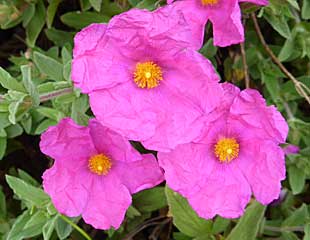
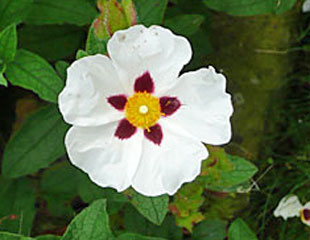
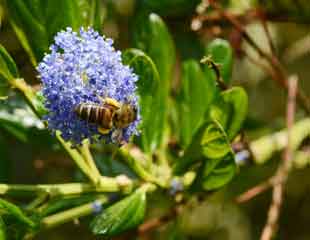
The 20 Drought-resistant Plants and Shrubs
As we emerge from the summer heatwaves of 2025, it's clear that watering daily to keep garden plants alive is unsustainable. More and more, we are looking for drought-tolerant plants and shrubs—varieties that can thrive in dry soils with little to no extra watering.
With all new planting, watering is necessary at the beginning, but once settled, many drought-resistant shrubs and plants will survive months without rain. These plants will bring colour to the garden, and many are bee and pollinator-friendly.
Tips on Gardening for Drought Conditions
In 2022, during another drought, the RHS did a survey to find out which plants suffered the most in the heatwave. This is really helpful to look at and compare with your own garden.
Crocus has great bargains for drought-resistant planting combinations (affiliate link), including many of the plants detailed below.
Drought resistant Shrubs for Hot Dry Borders
Ceanothus
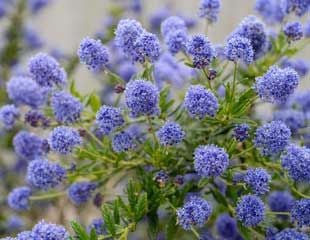
Key Facts:
Height: compact -3m
Light: Sun-loving
Soil: most well-drained, not ideal on chalk
Special Feature. Evergreen flowering shrub.
With the common name of Californian lilac, it's hardly surprising that it grows well in dry conditions. Described as hardy, it needs a sheltered spot away from chilly winds. In the right spot, it makes a spectacular shrub. Growing tips and advice.
Lavatera

Key Facts:
Height:
Light:
Soil:
Special Feature.
Lavatera grows up to around 2m with an abundance of lovely pink flowers throughout the summer, which resemble hollyhocks. Classified H5, this drought-resistant shrub will flower best in a sheltered spot. Relatively short-lived shrubs. An easy-to-grow deciduous shrub. Images and growing tips.
Lavender
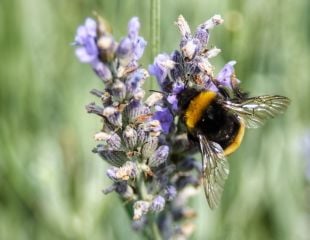
Key Facts:
Height: 30cm to 1m+
Light: full sun
Soil: light, well-drained
Special Feature. Lavender, a garden favourite, will not only thrive on dry soil, but it also positively hates wet soil, in which it performs poorly.
There is an enormous range of lavenders to choose from in size, colour and hardiness. Lavender is one of our best-known drought-resistant shrubs.
Rosemary
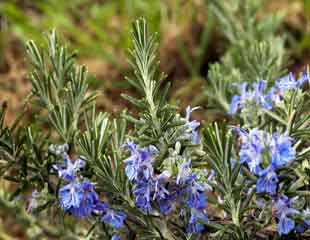
Key Facts:
Height: up to 1.5
Light: full sun, will tolerate little light shade.
Soil: light, free-draining, dry.
Special Feature. An excellent culinary herb and attractive evergreen shrub with blue flowers.
It is best planted in a sheltered spot away from cold winds. Its leaves are aromatic it has small blue flowers, but if you constantly snip the tips (as I do) for cooking, you may reduce flowering. More growing tips rosmarinus officinalis
Santolina
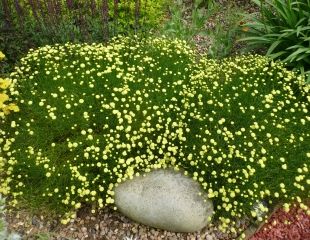
Key Facts:
Height: compact 1m
Light: full sun
Soil: well-drained
Special Feature. A low-growing shrub that thrives in dry, sunny spots, Santolina looks attractive as illustrated here, planted around a stone.
It has aromatic leaves, reaches about 1m, it is evergreen and is summer-flowering. Its common name is cotton lavender, and it is hardy to H5.
Perovskia

Key Facts:
Height: up to 1.5m
Light: full sun
Soil: any well-drained
Special Feature. Fully hardy will grow on poor soils and low maintenance.
The classification puts Perovskia as a sub-shrub, somewhere between a plant and a shrub. It is a woody plant with aromatic leaves, a bee magnet, late flowering throughout August and September; its common name is Russian Sage.
Perovskia is easy to grow and very drought resistant.
Artemisa
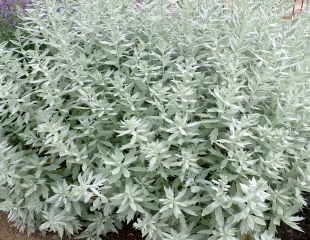
Key Facts:
Height: up to around 1m, depending on variety.
Light: full sun
Soil: well-drained, dry.
Special: lovely, soft silver foliage. Illustrated is a particularly nice form of Artemisia' Valarie Finnis'.
Many of the silver-leaved plants originate from the Mediterranean, which means they are inherently drought-resistant.
Drought resistant Perennial plants for Dry Borders
Stachys
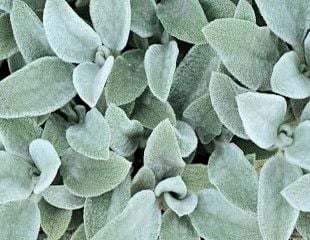
Key Facts:
Height: ground cover with tall spikes of flowers >50cm
Light: full sun
Soil: light, well-drained /poor soils
Special Feature. Hardy H7 Flowers are very attractive to bees including Wool Cader bee.
It forms a mat of soft, silky leaves. Common name Lamb's ears.
Erigeron

Key Facts:
Height: low, up to 50cm
Light: full sun, some shade
Soil: well-drained, dry
Special Feature: A long-flowering perennial from late spring throughout summer.
It is very tolerant of dry soils and has daisy-type flowers. Although flowers become less prolific, it's not unusual to flower right through to November. It is a self-seeder, hardy H5, and its common name is Mexican Fleabane. Growing tips.
Sedum
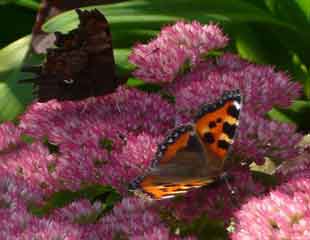
Key Facts:
Height: ground cover to .1m
Light: full sun
Soil: well-drained
Special Feature. Sedums are a magnet for bees, pollinators of all types, and butterflies.
Sedums range from low-growing ground cover to tall varieties reaching 1m. Most are fully hardy and, as perennials, retain their shape over winter. Growing tips. Sedums are succulents, which are plants that are able to store water to be drought resistant.
Achillea
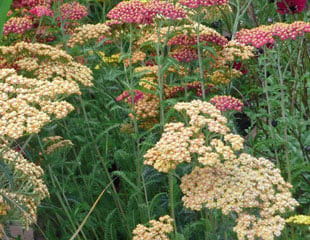
Key Facts:
Height: 60cm -2m
Light: full sun/partial shade
Soil: well-drained, dry.
Special Feature. Large flat flowers with attractive feathery foliage.
Achillea is a herbaceous summer-flowering perennial. An ideal border plant because of the wide range of flower colours, ranging from muted shades as illustrated, but also bright cerise, terracotta, yellow, red; much to choose from,and growing advice.
Agapanthus
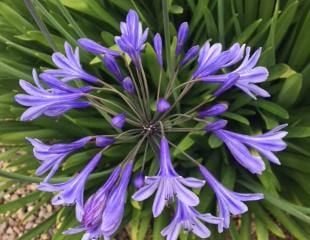
Key Facts:
Height: 40cm to 1m
Light: full sun
Soil: light, well-drained
Special Features: bold architectural flowers in shades of blue, purple, stripy and pink.
There are both evergreen and herbaceous varieties, and not all are fully hardy and may need winter protection. Agapanthus is ideal for growing in containers, where the tendency to dry conditions will suit it.
The drought-resistant nature of Agapanthus allows them to grow semi-wild in the Scilly Isles. Tips and planting advice.
Eryngium
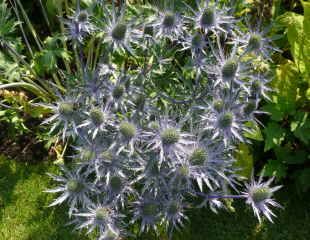
Key Facts:
Height: wide, 3cm to 3M
Light: full sun
Soil: dry, well-drained
Special Feature. The common name is Sea Holly; it has thistle-like flowers and is tolerant of salty conditions in coastal gardens.
Flowers in shades of blue or white, easy to grow and low maintenance. Most varieties are hardy to H5 and are best planted in a sheltered spot in full sun.
Echinops

Key Facts:
Height: wide 50cm -2m
Light: full sun, partial shade
Soil: any well-drained
Special Feature: Lovely silver-blue foliage and globes of blue flowers, which are loved by bees.
It is very hardy, rated H7, and as illustrated, it looks lovely combined with Monarda and Stipa gigantea, making for a colourful late summer display.(credit image RHS Harlow Carr Jason Ingram)
Stipa
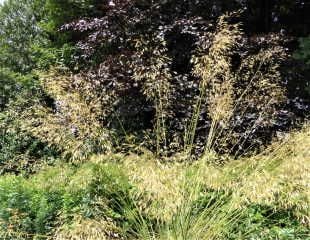
Key Facts:
Height: wide .5- 3m
Light: full sun/some shade
Soil: well-drained
Special Feature. Many grasses are drought-tolerant, as is Stipa gigantea, with tall airy plumes of oat grass towering up to 2m it can look very dramatic in borders.
There are other grasses which are drought resistant, such as Pennisetum, Miscanthus and blue grasses.
Verbascum
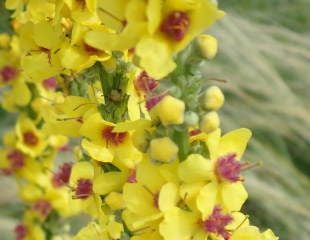
Key Facts:
Height: Flower spike up to 2m
Light: Sun
Soil: including poor soils if well-drained.
Special Feature. Very attractive flower plumes, white, yellow, orange, blue and purple.
Verbascum is a perennial or largely biennial, summer-flowering plant tolerant of dry conditions.
It tends to self-seed.
Pelargonium
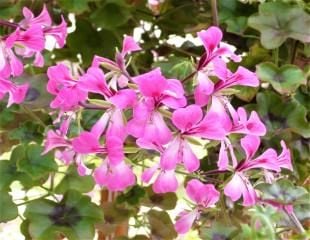
Key Facts:
Height: .5-1m
Light: full sun
Soil: well-drained
Special Feature. As a drought-resistant plant for a hanging basket, Pelargoniums are ideal. They will tolerate drought and hot sunshine.
The predominance of Pelargoniums in Mediterranean gardens and baskets is a testament to their drought tolerance.
Eremurus

Key Facts:
Height: 1.5-1.8M
Light: Full sun
Soil: light, sandy, well-drained
Special Feature.Also known as Fox tail Lily, this is a tall perennial grown from tubers planted in autumn.
Hardy in dry conditions, a mulch over the winter will help to protect the tubers. Eremurus will self-seed.
Thymus
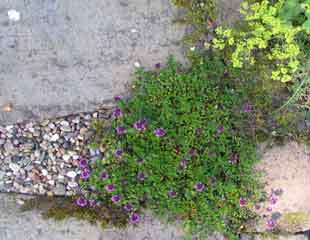
Key Facts:
Height: low up to 30cms
Light: full sun/partial shade
Soil: dry, poor, well drained.
Special Feature. Ideal for growing in cracks and crevices. There is a wide range of Thyme varieties available with attractive flowers, which are much visited by bees.
Thyme is a low growing mat forming hardy perennial, and it grows best in full sun. More about growing herbs.
Verbena
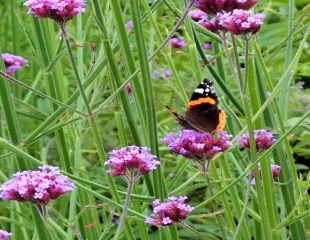
Key Facts:
Height: 20cms -2m
Light: Sun
Soil: well-drained
Special Feature. A good drought-resistant perennial, it is also very attractive to pollinators and butterflies.
It is a herbaceous perennial. Commonly grown is a tall variety up to around a metre, but you can also buy V. "Lollypop" a compact variety. Requiring little or no watering Verbena is ideal for a gravel garden.
Salvia
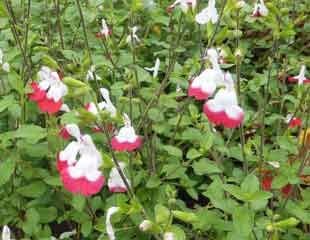
Key Facts:
Height: 20cm to 2M
Light: Sun/partial shade
Soil: Well drained
Special Feature.Salvia does well in hot dry conditions and is particularly adverse to winter wet.
The variety illustrated is 'Hot lips'. Some salvias are borderline hardy and may not return reliably in wet soil, which makes them a perfect plant for dry drought conditions. In addition, it is very long-flowering.
Star Jasmine
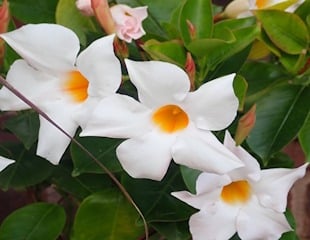
Key Facts:
Height: Up to 8M
Light: sun/light shade
Soil: well-drained
Special Feature. This is Trachelospermum jasminoides, an evergreen, climbing plant.
Suited to both sun and partial shade. It is not actually a Jasmine, it's hardy, although best in a sheltered spot, and it has scented flowers. Check also Jasminum fruticans, a semi-evergreen, summer-flowering shrub.

